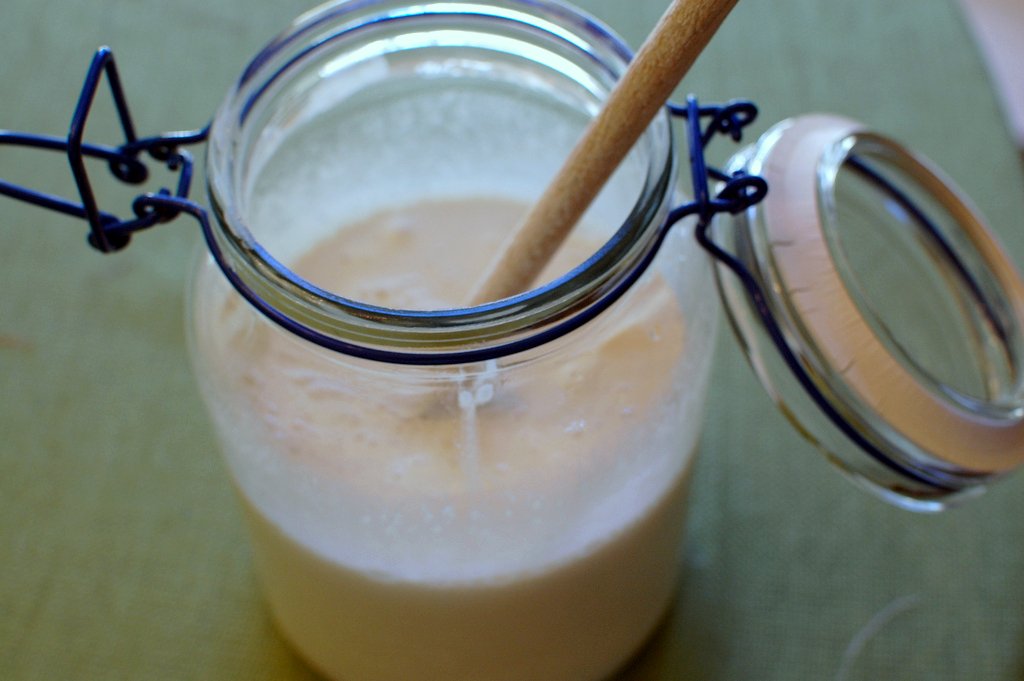So, think about that while you read the following. There are three kinds of ways that you can get sourdough starter:
- You can get some from someone who currently has starter. People claim to have strains that came across the plains on the Oregon trail. How cool is that?? There's also a website called King Arther Flour that sells sourdough starter. Their strain of wild yeast was developed back East and has been around for over 250 years. How cool is that?? Here's the link: http://www.kingarthurflour.com/shop/yeast-baking/sourdough-and-starters. You can buy an ounce of starter for about seven dollars, and it comes with instructions and recipes. I really need to break down and buy some, because I'm dying to compare it to the starter that I made. Which brings me to option number two: make your own.
- You can make your own starter either by catching wild yeast that resides in the air, the flour that you're using, the potato water that you saved, the red cabbage leaf or grape that you put in it. There are lots of ways to capture wild yeast. And they all have a slightly different flavor depending on your method. This is the old school way, the way that all sourdough snobs swear by. The one that old-timers will recall with fondness and tell you firmly, "You don't use anything in your starter except flour and water!!"...at least that's what Don's grandpa told us. And this brings me to option number three:
- You cheat. By giving your starter a boost with domestic yeast. That's what I did, and it's worked out loverly for me. Don't tell Don's grandpa. My little starter baby is now 2 1/2 months old, and thriving. I gauge it's health by how well it works, and the amount of liquid (called "hooch" in sourdough language) that collects on the top. Hooch is a good sign, and nothing to be afraid of. It's kind-of like mild, harmless, beer...that won't get you drunk. It's a byproduct that shows that your yeast is thriving. If your starter is dry, stir it in, if it's just right, pour it off. Oh, bytheway, should you make your own starter, and the bread doesn't taste very sourdoughy, don't worry, the starter will get stronger with time. Here's a picture of what my starter looks like:
See the layer of liquid? Hooch! It's kind-of scary looking, I know. Here's how it looks after it's been stirred in:
It looks a little better now. Here's the recipe for the starter, should you decide to make your own. In later posts I'll show you how to take care of and use your starter.
Sourdough Starter
- 1 pkg. active dry yeast
- 2 1/2 cups warm water
- 2 cups all-purpose flour
- 1 tablespoon sugar or honey
Storing:
To store your starter you can use a glass/plastic/special sourdough crock that is about double the size of the amount of starter you have. Make sure it has a lid, and make sure none of the starter gets on the mouth area, because the stuff acts like concrete, and it will be tough to get it off.
I'll blog more about how to take care of your starter soon! In the meantime, try it out, it'll surprise you with how uncomplicated it is.
![[erin's star signature]](http://farm4.static.flickr.com/3230/3048671754_d0e3f03290.jpg?v=0)






i, too, am scared of it. i don't want something...living...in a jar on my counter. perhaps i need to overcome my fears, because dang sourdough is good!
ReplyDelete